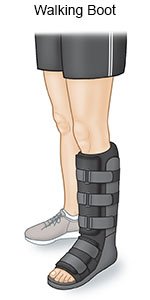Toe Fracture in Children
Medically reviewed by Drugs.com. Last updated on Aug 4, 2025.
A toe fracture is a break in a bone in your child's toe.
 |
DISCHARGE INSTRUCTIONS:
Return to the emergency department if:
- Blood soaks through your child's bandage.
- Your child has severe pain in his or her toe.
- Your child's toe is cold or numb.
Call your child's doctor if:
- Your child has a fever.
- Your child's pain does not go away, even after treatment.
- Your child's toe continues to hurt even after it has healed.
- You have questions or concerns about your child's condition or care.
Medicines:
Your child may need any of the following:
- NSAIDs , such as ibuprofen, help decrease swelling, pain, and fever. This medicine is available with or without a doctor's order. NSAIDs can cause stomach bleeding or kidney problems in certain people. If your child takes blood thinner medicine, always ask if NSAIDs are safe for him or her. Always read the medicine label and follow directions. Do not give these medicines to children younger than 6 months without direction from a healthcare provider.
- Acetaminophen decreases pain and fever. It is available without a doctor's order. Ask how much to give your child and how often to give it. Follow directions. Read the labels of all other medicines your child uses to see if they also contain acetaminophen, or ask your child's doctor or pharmacist. Acetaminophen can cause liver damage if not taken correctly.
- Antibiotics help prevent or treat a bacterial infection.
- Do not give aspirin to children younger than 18 years. Your child could develop Reye syndrome if he or she has the flu or a fever and takes aspirin. Reye syndrome can cause life-threatening brain and liver damage. Check your child's medicine labels for aspirin or salicylates.
- Give your child's medicine as directed. Contact your child's healthcare provider if you think the medicine is not working as expected. Tell the provider if your child is allergic to any medicine. Keep a current list of the medicines, vitamins, and herbs your child takes. Include the amounts, and when, how, and why they are taken. Bring the list or the medicines in their containers to follow-up visits. Carry your child's medicine list with you in case of an emergency.
Manage your child's symptoms:
- Help your child rest so the toe can heal. He or she can return to normal activities as directed.
- Apply ice on your child's toe for 15 to 20 minutes every hour or as directed. Use an ice pack, or put crushed ice in a plastic bag. Cover it with a towel. Ice helps prevent tissue damage and decreases swelling and pain.
- Elevate your child's toe above the level of the heart as often as you can. This will help decrease swelling and pain. Prop your child's toe on pillows or blankets to keep it elevated comfortably.

- Use buddy tape, an elastic bandage, or a splint to help keep your child's toe in its correct position as it heals. Buddy tape means the fractured toe and the toe next to it are taped together.
- Have your child use a support device such as a cane, crutches, walking boot, or hard soled shoe. These help protect your child's broken toe and limit movement so it can heal.

Follow up with your child's doctor as directed:
Write down your questions so you remember to ask them during your visits.
© Copyright Merative 2025 Information is for End User's use only and may not be sold, redistributed or otherwise used for commercial purposes.
The above information is an educational aid only. It is not intended as medical advice for individual conditions or treatments. Talk to your doctor, nurse or pharmacist before following any medical regimen to see if it is safe and effective for you.
Learn more about Toe Fracture
Care guides
Further information
Always consult your healthcare provider to ensure the information displayed on this page applies to your personal circumstances.
